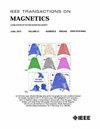Research on a Novel Concentrated-Winding and Unequal Tooth Linear Permanent Magnet Vernier Machine
IF 2.1
3区 工程技术
Q3 ENGINEERING, ELECTRICAL & ELECTRONIC
引用次数: 0
Abstract
In this article, a novel concentrated-winding and equal tooth structure linear permanent magnet vernier machine (ET-LPMVM) is developed to facilitate coils embedded in the armature while maintaining performance equivalent to the conventional linear permanent magnet vernier machine (C-LPMVM). The electromagnetic parameters of ET-LPMVM, such as no-load air-gap flux density, no-load back electromotive force (EMF), inductance, and thrust, are compared and analyzed with C-LPMVM. The electromagnetic performance of ET-LPMVM is verified by a semi-analytical method and FEM, and the results of both methods are basically the same. To further enhance the machine’s performance, a novel unequal tooth linear permanent magnet vernier machine (UNET-LPMVM) is proposed based on the ET-LPMVM. The unequal tooth structure is employed to enhance the back EMF and thrust density, and the thrust improvement mechanism of the proposed machine is analyzed by the Maxwell stress tensor (MST) method. Minimum thrust ripple and high thrust are obtained by optimizing the key parameters of the proposed machine. Compared with ET-LPMVM and C-LPMVM, the average thrust of the proposed UNET-LPMVM is 36.43% and 28.73% higher than the ET-LPMVM and C-LPMVM, respectively. Furthermore, the thrust ripple of the proposed machine is reduced from 18.84% to 2.96%. The analysis results show that the proposed UNET-LPMVM has a better flux modulation effect and thrust characteristics.一种新型集中卷绕等齿直线永磁游标机的研究
本文设计了一种新颖的集中卷绕等齿结构线性永磁游标机(ET-LPMVM),使线圈能够嵌入电枢中,同时保持与传统线性永磁游标机(C-LPMVM)相当的性能。对ET-LPMVM的空载气隙磁通密度、空载反电动势、电感、推力等电磁参数与C-LPMVM进行了比较分析。采用半解析法和有限元法对ET-LPMVM的电磁性能进行了验证,两种方法的结果基本一致。为了进一步提高机器的性能,在ET-LPMVM的基础上,提出了一种新型不等齿线性永磁游标机(UNET-LPMVM)。采用不均匀齿形结构增强反电动势和推力密度,并采用麦克斯韦应力张量(MST)方法分析了该机床的推力提升机理。通过对关键参数的优化,实现了推力脉动最小和推力高的目标。与ET-LPMVM和C-LPMVM相比,本文提出的UNET-LPMVM的平均推力分别比ET-LPMVM和C-LPMVM高36.43%和28.73%。此外,该机器的推力脉动从18.84%降低到2.96%。分析结果表明,所提出的UNET-LPMVM具有较好的磁链调制效果和推力特性。
本文章由计算机程序翻译,如有差异,请以英文原文为准。
求助全文
约1分钟内获得全文
求助全文
来源期刊

IEEE Transactions on Magnetics
工程技术-工程:电子与电气
CiteScore
4.00
自引率
14.30%
发文量
565
审稿时长
4.1 months
期刊介绍:
Science and technology related to the basic physics and engineering of magnetism, magnetic materials, applied magnetics, magnetic devices, and magnetic data storage. The IEEE Transactions on Magnetics publishes scholarly articles of archival value as well as tutorial expositions and critical reviews of classical subjects and topics of current interest.
 求助内容:
求助内容: 应助结果提醒方式:
应助结果提醒方式:


